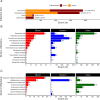Predictive modelling of hospital-acquired infection in acute ischemic stroke using machine learning
- PMID: 39730788
- PMCID: PMC11680783
- DOI: 10.1038/s41598-024-82280-3
Predictive modelling of hospital-acquired infection in acute ischemic stroke using machine learning
Abstract
Hospital-acquired infections (HAIs) are serious complication for patients with acute ischemic stroke (AIS), often resulting in poor functional outcomes. However, no existing model can specifically predict HAI in AIS patients. Therefore, we employed the Gradient Boosting matching learning algorithm to establish predictive models for HAI occurrence in AIS patients and poor 30-day functional outcomes (modified Rankin Scale > 2) in AIS patients with HAI by analyzing electronic health records from 6560 AIS patients. Model performance was evaluated through internal cross-validation and external validation using an independent cohort of 3521 AIS patients. The established models demonstrated robust predictive performance for HAI in AIS patients, achieving area under the receiver operating characteristic curves (AUROCs) of 0.857 ± 0.008 during internal validation and 0.825 ± 0.002 during external validation. For AIS patients with HAI, the second model effectively predict poor 30-day functional outcomes, with AUROCs of 0.905 ± 0.009 during internal validation and 0.907 ± 0.002 during external validation. In conclusion, machine learning models effectively identify the HAI occurrence and predict poor 30-day functional outcomes in AIS patients with HAI. Future prospective studies are crucial for validating and refining these models for clinical application, as well as for developing an accessible flowchart or scoring system to enhance clinical practices.
© 2024. The Author(s).
Conflict of interest statement
Declarations. Competing interests: The authors declare no competing interests.
Figures



Similar articles
-
Predictive etiological classification of acute ischemic stroke through interpretable machine learning algorithms: a multicenter, prospective cohort study.BMC Med Res Methodol. 2024 Sep 10;24(1):199. doi: 10.1186/s12874-024-02331-1. BMC Med Res Methodol. 2024. PMID: 39256656 Free PMC article.
-
Prediction of hospital-acquired influenza using machine learning algorithms: a comparative study.BMC Infect Dis. 2024 May 2;24(1):466. doi: 10.1186/s12879-024-09358-1. BMC Infect Dis. 2024. PMID: 38698304 Free PMC article.
-
Machine Learning-Based Clinical Prediction Models for Acute Ischemic Stroke Based on Serum Xanthine Oxidase Levels.World Neurosurg. 2024 Apr;184:e695-e707. doi: 10.1016/j.wneu.2024.02.014. Epub 2024 Feb 8. World Neurosurg. 2024. PMID: 38340801
-
An interpretable hybrid machine learning approach for predicting three-month unfavorable outcomes in patients with acute ischemic stroke.Int J Med Inform. 2025 Apr;196:105807. doi: 10.1016/j.ijmedinf.2025.105807. Epub 2025 Jan 22. Int J Med Inform. 2025. PMID: 39923294
-
Advanced Machine Learning Models for Predicting Post-Thrombolysis Hemorrhagic Transformation in Acute Ischemic Stroke Patients: A Systematic Review and Meta-Analysis.Clin Appl Thromb Hemost. 2024 Jan-Dec;30:10760296241279800. doi: 10.1177/10760296241279800. Clin Appl Thromb Hemost. 2024. PMID: 39262220 Free PMC article.
References
-
- Vermeij, F. H. et al. Stroke-associated infection is an independent risk factor for poor outcome after acute ischemic stroke: Data from the Netherlands stroke survey. Cerebrovasc. Dis.27, 465–471. 10.1159/000210093 (2009). - PubMed
-
- Aslanyan, S. et al. Pneumonia and urinary tract infection after acute ischaemic stroke: A tertiary analysis of the GAIN international trial. Eur. J. Neurol.11, 49–53. 10.1046/j.1468-1331.2003.00749.x (2004). - PubMed
MeSH terms
Grants and funding
LinkOut - more resources
Full Text Sources
Medical

